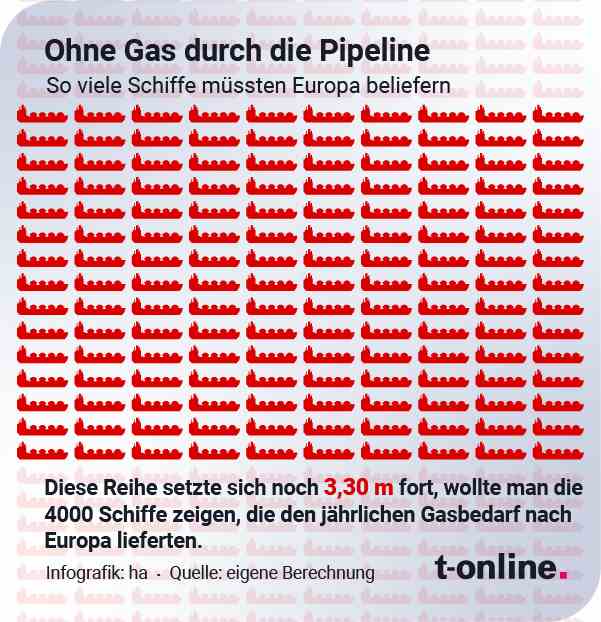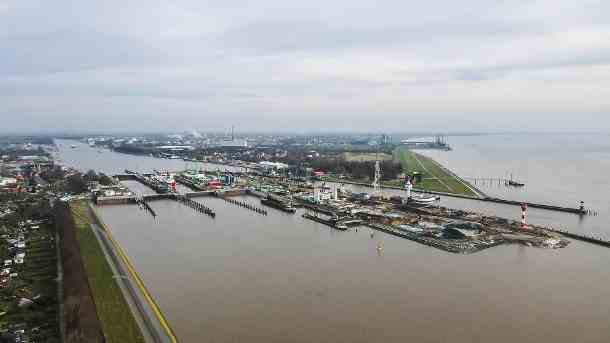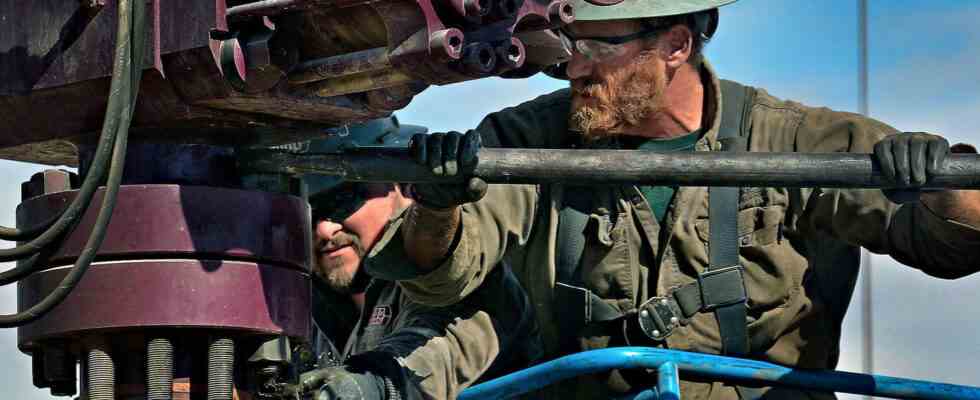LNG is to become the alternative to Russian gas. Economics Minister Habeck is currently jetting around the world for this. t-online explains what LNG is all about and how the supply in Germany could look like.
The Russian war of aggression on the Ukraine triggered a turning point in German energy policy. Alternatives to Russian gas imports are now being desperately sought. Federal Minister of Economics Robert Habeck therefore recently negotiated with Qatar about liquid gas supplies.
t-online explains how LNG works, how it could be used in Germany and whether it will actually end dependence on Russian gas.
What is LNG?
LNG is the abbreviation for “liquefied natural gas”, which is frozen natural gas liquefied under high pressure. The gas has to be cooled down to -161 to -164 degrees Celsius.
Since liquefied natural gas is only 1/600th the volume of gaseous natural gas, it can be transported by tanker, truck and train instead of pipelines.
Good to know: LNG and LPG are not the same. LNG stands for liquefied natural gas, while LPG means liquid gas, i.e. “liquefied petroleum gas”.
How does it work?
The natural gas is fed from the extraction sites into a liquefaction plant. The natural gas usually consists of a mixture of methane, hydrocarbons, nitrogen, carbon dioxide, water and undesirable components such as sulfur compounds. The latter are removed before further processing. After that, the methane content is 98 percent, which makes LNG a particularly pure gas.
The gas is cooled down in several steps, making it liquid. In this form it can be loaded and delivered, which is usually done by ships. The liquefied natural gas is then stored in insulated storage tanks in the terminals.
LNG delivery from Qatar at the Chinese port of Tianjin: In order to get rid of Russian gas, Germany now wants to build two liquefied natural gas terminals. (Source: imago images)
Where does Germany currently get gas from?
So far, Germany has obtained its gas via pipelines. Around 55 percent will do so Russia imported. Germany buys another 30 percent from Norway and 12 percent from the Netherlands.
The large share of Russian gas explains why an embargo is being hotly debated. On the one hand, it would cut off a major source of revenue for Russia, but on the other, it would pose a supply problem for Germany.
How easy or difficult this could be to solve in the short term is debatable. LNG deliveries are an alternative, but so far there are no terminals in Germany that handle liquid gas from the USA accept and disseminate. In Europe as a whole, the situation is somewhat different: 37 terminals ensure that around a quarter of Europe’s gas requirements can be met with LNG.
Is LNG an alternative to Russian gas?
For cost reasons, it was not previously, because the energy requirement for the liquefaction described above is very high, around 10 to 25 percent of the energy content of the gas.
Accordingly, this only pays off from a transport distance of around 2,500 kilometers. Below this distance, transport via a natural gas pipeline is energetically more economical. That is why the current main importers of LNG are Asian countries such as Japan, South Korea and Taiwan, accounting for almost 80 percent of the global volume. A smaller share also goes to Great Britain, Italy and Belgium.

As a result of the Russian invasion of Ukraine and the resulting Western sanctions, there are calls to stop gas imports and fears that Russia could stop exporting. This makes LNG interesting as an alternative.
In 2020, Germany received 56 billion cubic meters of gas from Russia via three pipelines. To equalize this amount, about 750 tanker loads would be needed, which typically hold between 125,000 and 147,000 cubic meters. And that although the liquefied gas already has 600 times less volume.
In relation to the whole of Europe, more than 4,000 tanker loads would be necessary. Some countries are already preparing for this: one of the largest terminals is in Rotterdam. The capacities here are currently being increased to 13.5 billion cubic meters per year.
What are the politicians planning?
Two of its own LNG terminals are to be built in Germany. One of them in Brunsbüttel, Schleswig-Holstein. The construction is supported by the federal government with half a billion euros. This keeps the KfW 50 percent.
The Dutch gas network operator Gasunie, which belongs to the Dutch state, will hold a further 40 percent, the remaining 10 percent will be held by the German energy group RWE. Gasunie will be the operator. The second terminal is to be built in Wilhelmshaven in Lower Saxony.
 Port of Brunsbüttel: One of the first German terminals for liquefied natural gas (LNG) is to be built here. (Source: Frank Molter/dpa)
Port of Brunsbüttel: One of the first German terminals for liquefied natural gas (LNG) is to be built here. (Source: Frank Molter/dpa)
But terminals alone are not enough, LNG must also be delivered there accordingly. To this end, Federal Economics Minister Robert Habeck has held talks with Norway and Canada in recent weeks. Then, over the weekend, he signed a long-term energy partnership with Qatar, one of the world’s largest LNG exporters. Read here why this is controversial.
Habeck had said before that he wanted to open doors for German companies and some business representatives were there, including the boss of thyssenkrupp as well as the bosses of Bayer, RWE and Siemens Energy.
However, the new terminals do not represent a short-term solution. A construction period of three to four years is expected. However, the federal government wants to take care of faster approvals. Work is already underway in Wilhelmshaven on an interim solution that is intended to secure the winter of 2023: a so-called Floating Storage and Regasification Unit (FSRU). This is an LNG terminal on a ship. In this way, an annual volume of 9 to 10 billion cubic meters could be created.

